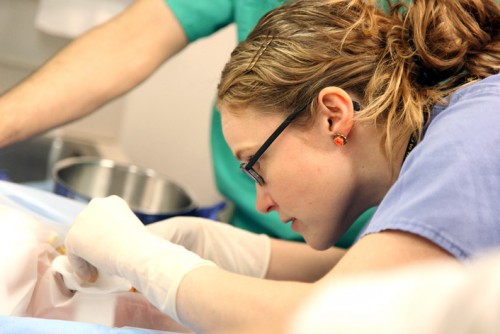Infant Circumcision Now Both Advised and Safer
I’m not sure how to write about some new research on infant circumcision because I am aware that the subject has seemed to develop sort of a cult of non-believers not dissimilar to that of the non-immunizers.
Circumcisions shown beneficial but controversy continues
Frankly, on both issues I’ve found people who I call friends but need to steer completely clear of any hint of a discussion with them on the subjects.
Battlefront Over Circumcision
If someone in our group makes a statement that even looks like it might lead to the topic I can see eyes start to dilate, breathing increase and glabellar folds begin to deepen; and, I’ve learned to quickly try and change the subject before any “rankles go up.” The topics have become that emotionally charged for them that it’s difficult to even discuss a new research study.
That reason makes me a bit hesitant to broach the subject here – and I don’t even intend to discuss anything except this one journal article because I think it needs to be noticed; just as I also need to point out that the American Academy of Pediatrics (AAP) has actually reversed it’s recommendations now in light of substantial and verifiable research that benefits outweigh the risks of performing the procedure.
And secondly, I have to say that this new study published in the Journal of the American Medical Association (JAMA) May 2015 edition is a bit confusing and has a few problems with design. However, it’s just so… honkin’… massive – 2,339,760 children over 10 years – that the prudent thing for an intellectually honest person to do is to at least take notice!
The study showed that male circumcision is unlikely to have adverse events (AEs) if performed before 1 year of age but that the risk increases up to 20-fold if the procedure is delayed. And the AAP, since 2012, now advises: “the procedure’s benefits justify access to this procedure for families who choose it” based on the findings of 3 randomized controlled trials showing that circumcision protects against infection by HIV.
In light of all the controversy, and the fact that new research is showing that circumcision protects against AIDS, and the fact that countries with enacted circumcision programs are actually seeing benefits, and the reversal of CDC, AMA and AAP recommendations, the study authors set out to see what the “reality” was for complications of the procedure.
Circumcision metaData Study
Several PhD’s from the University of Washington, Seattle reviewed the medical bills collected in the SDI Health administrative database which covers medical claims from hospitals and physicians offices in all 50 US states – millions of children.
Claims data in their huge database included 2,339,760 newborn males between 2001 and 2010. Of those, 1,306,812 (55.9%) underwent circumcision, with 93.3% undergoing the procedure before the age of 1 year.
They began by identifying 41 possible physician’s office staff’s billing and diagnosis codes that might possibly be adverse events (AEs) and assigned length-of-time “windows” where, if they were billed, they might be related to the circumcision; such as: “repair of circumcision,” “artery suture,” and “lysis of penile adhesions.” That’s the problem with numbers in the millions – you want the computer to do all the work and not have to read any actual records.
When the computer crunched and correlated it discovered a total of 5385 AEs among circumcised newborns; but, also 1100 of those supposed Circ-related AEs among UNcircumcised newborns. Of course they calculated the percentage-risk for each of their 41 AEs which was quite variable but the statistics for circumcision were just under a half of a percent over all (0.4%). Rates for stricture (7 per million) were lower than for Lysis/repair (700 per million) but no attempts were made to correlate clinically.
Next, oddly enough, the computer found that circumcised newborns had significantly higher risks for having billing codes for wounds, inflammation, and bleeding than the uncircumcised newborns. However, they had lower risks for surgical procedures, penile disorders, gangrene, and infections! [Huh?]
It surprises absolutely no physician that the computer pulled out more of the codes for what they were calling AEs in older children and adults than it did for newborns and infants. In boys circumcised as infants there was found 0.4% risk of having one of the 41 problem codes. If the circumcision was done between 1 and 9 the number of AEs jumped to 9% and those over 10 it was 5.3%.
Once tissues have grown, just as in tonsillectomies, it’s a “bigger deal” to have surgery on them. The difference in the numbers for children greater than 1 may not be significant but they point that there was a “20-fold” and “10-fold” increase – although one could argue the difference between 0.4 and 9 out of 100 isn’t that great.
In their defense the researchers did list the limitations of their study (although they failed to even mention the veracity or ‘inflation’ of the data) and didn’t overstate their conclusions. They pointed out difficulties in “assigning risk windows,” generalizability, restriction of procedures to those that had been billed and the lack of inclusion of circumcision in nonmedical settings, such as a religious ceremony.
Their conclusions were simply that “the risk for an AE associated with circumcision performed before 1 year of age is less than 0.5% and that healthcare providers can use this result to counsel parents about whether or not to circumcise their sons.”
For the reasons I’ve stated it is almost certain that the “real” percentage of adverse events is lower and these numbers are inflated; however, as the researchers stated, we can assure parents that risk of adverse events in a circumcision is less than a half of a percent and probably much less. Additionally, there seems to be no argument that performing the procedure as an infant carries much less risk and emotional trauma as does having it performed by a skilled pediatrician.
[JAMA Pediatrics. Published online May 12, 2014. Abstract ]
Advertisement by Google
(sorry, only few pages have ads)



